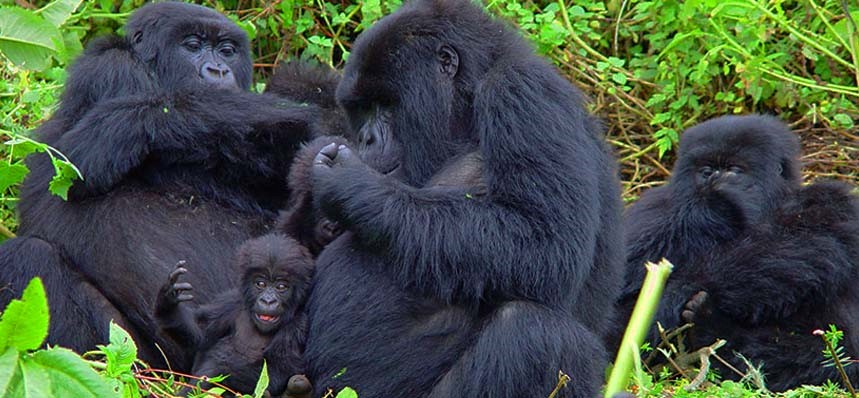WHAT IS THE DIFFERENCE BETWEEN CHIMPANZEE HABITUATION VS GORILLA HABITUATION IN UGANDA

Are you interested in participating in chimpanzee habituation or gorilla habituation in Uganda, where you will have the opportunity to get a close-up view of the various primates in the wild? For tourists interested in seeing primates in the wild, chimpanzee trekking is the most popular activity. Chimpanzee safaris in Uganda are quite memorable. However, for tourists interested in getting a close-up view of the chimpanzees, you can take part in chimpanzee habituation in Uganda, which is only conducted in the Kibale Forest National Park. Other national parks that offer chimpanzee trekking are Queen Elizabeth National Park, Budongo Forest, and Kibale National Park. On the other hand, gorilla habituation is only done in Bwindi Impenetrable Forest National Park, despite the fact that both Bwindi Impenetrable National Park and Mgahinga National Park in Uganda offer opportunities for gorilla trekking.
There are several aspects of the activities that you should take into consideration before participating in them for an incredible experience while choosing between chimpanzee habituation in Uganda and gorilla habituation in Uganda. These include:
While taking part in gorilla habituation, you'll become aware that there are only four participants in gorilla habituation in Uganda. This is due to the fact that gorillas are a vulnerable species, whereas only six people take part in chimpanzee trekking. As a result, chimpanzee habituation offers visitors more opportunities to participate in other activities than gorilla habituation in Uganda.
When you see a gorilla, you will realize that they live in families, which makes gorilla habituation more organized and less difficult than that of chimpanzees, who are more playful and are found in groups of many chimpanzees, hence making chimpanzee habituation much more difficult than gorilla habituation. Gorillas are the gentlest species that don’t disturb "gentle giants."
When comparing the two methods of acclimating the primate species to human presence, the cost of chimpanzee or gorilla habituation in Uganda is an important factor to consider. Both the gorilla and chimpanzee habituation permits can be obtained from the Uganda Wildlife Authority or a tour operator in Uganda. Travelers interested in chimpanzee habituation in Uganda must pay $250 per person, and those interested in gorilla habituation in Uganda must pay $1,500 for a gorilla habituation permit in Uganda.
According to the Uganda Wildlife Authority, you can also book a variety of tourist activities in Uganda, such as a boat tour through Murchison Falls National Park, a hike through the Virunga Mountains, an opportunity to track lions in Queen Elizabeth National Park, and other unforgettable experiences for a successful safari.
While normal gorilla trekking lasts an hour with the gorilla families in Uganda, chimpanzee habituation trekking is a full-day activity that involves tourists hiking to chimpanzee troops, so you will get to spend more time with the chimpanzee troop. Chimpanzee vs. Gorilla Habituation in Uganda: Which is Better? On the other hand, gorilla habituation for four hours makes chimpanzees much more fulfilling because you will get to spend more hours with the primates.
Travelers who are interested in gorilla trekking can visit a variety of African locations where they can have a variety of rewarding experiences in addition to having an amazing time watching the various gorilla species. For instance, if you're interested in gorilla trekking in the Congo, you can either do it in Virunga National Park, where you can see mountain gorillas in the country, or in Kahuzi Biega National Park in the country to see the critically endangered eastern lowland gorillas.
You can go chimpanzee trekking in other nations as well as visit the Senkwenkwe gorilla orphanage and the Lwiro chimpanzee sanctuary to learn more about how the primates are cared for in captivity before they are returned to the wild. Going on a gorilla trek in Rwanda is also rewarding because you can see not only the habituated gorilla families, but you can also visit Dian Fossey's grave while on the Dian Fossey hike to learn more about her legacy and her contributions to the habituation of gorillas in Africa.
